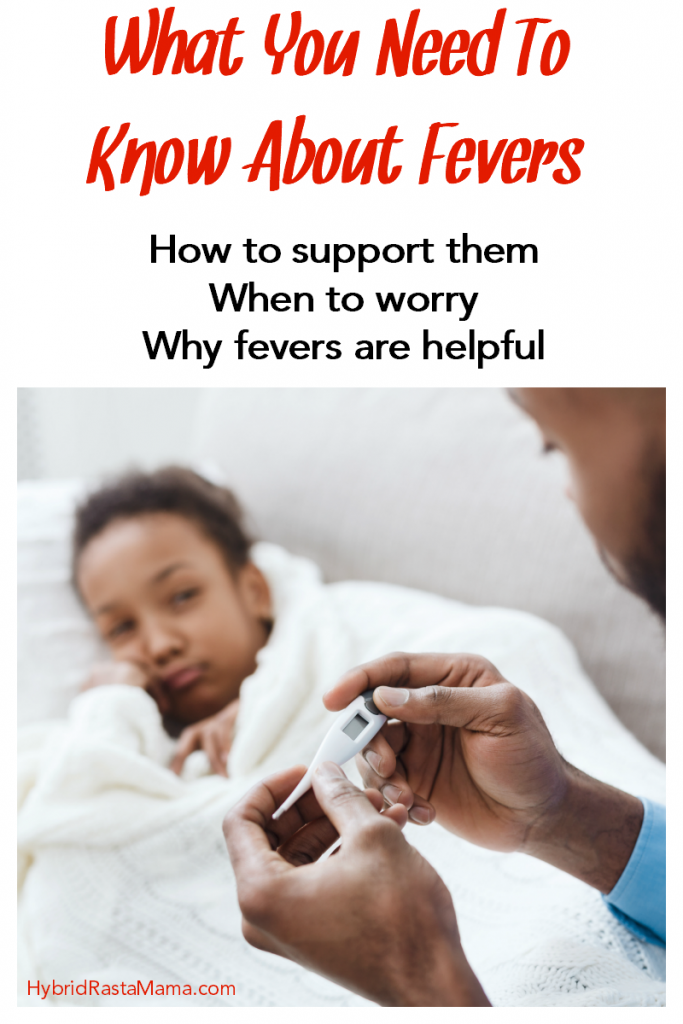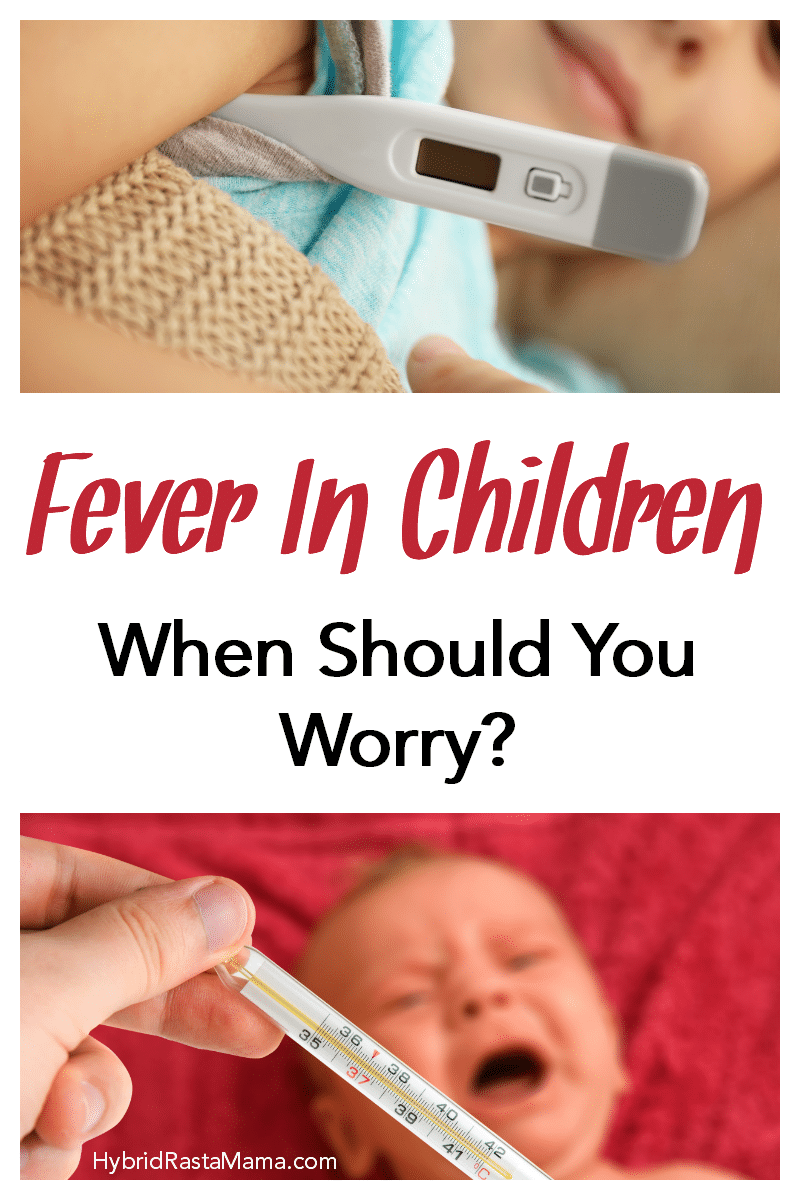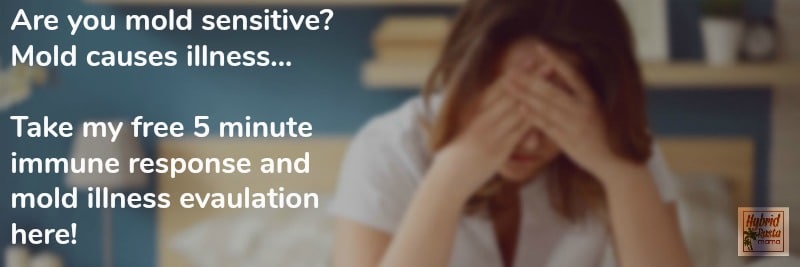There are two camps of parents when it comes to the topic of fever in children. On one side, you have the parents that fear fever and will do everything possible to suppress or “break it.” On the other side, you have parents who see the value of a fever and do not believe in suppressing it. They leave it alone and let nature run its course.
I am in the second camp. I really do not do anything when Tiny has a fever. I let nature do what nature does best.
I wasn’t always there. I actually was one of the panicky mothers the first time Tiny had a fever. However, after reading You Are Your Child’s First Teacher by Rahima Baldwin Dancy, I changed my tune completely.
“Childhood Fevers” is a wonderful article by Rahima Baldwin Dancy. It is basically an excerpt from the above mentioned book. It addresses how fevers can strengthen the immune system and how childhood illnesses can help a child’s development. I highly encourage you to read it. I learned quite a bit! I especially like her discussion on how to care for an ill child. She gets to the heart of what matters…your child’s health.

Fever In Children – What You Need To Know
Disclaimer time! I am not a licensed medical professional nor do I play one on this site so please do not take a single thing I write here to be bonafide medical advice. Whatever I share here is based on my personal experience, research, and possibly the experience of others. I am not making any medical claims. So take what I write and consult with your trusted practitioner before making any changes.
Naturopathic treatment is to support a fever, unless it rises too high or too quickly. A fever of 102.2°F (39°C) to 103°F (39.4°C) is considered the optimal defense against microbes. Temperatures like these also help the body most effectively.
Remember that fever is not a disease but rather a symptom of an illness.
Naturopathic doctors compare the warning system of fever symptoms to the warning system of your car’s engine light. To suppress a fever is like asking your mechanic to disconnect the engine light, rather than asking him or her to identify and fix the problem that caused the light to come on in the first place. Parents should ask themselves how they can approach their children’s symptoms as logically as they approach their cars: do we really want to suppress our warning signals? In the case of fever, the warning signal is much more of an aid to conquering illness, rather than as a source of damage in itself.
Why Children Get Fevers
- To stimulate the immune system.
- To create an inhospitable environment for invading organisms.
- To turn up the heat high enough that the invading microbes cannot live.
The Benefits of Fevers in Children
- Increased antibodies – cells trained to specifically attack the exact type of invader that your body is presently suffering from, produced more specific to that bug than any pharmaceutical agent.
- More white blood cells (the good guys) produced, circulating, mobilizing and armed to fight off the invading bugs.
- More interferon produced (another immune system good guy, which blocks spread of viruses to healthy cells).
- Walling off oiron, on which bacteria feed.
- Increased temperature, which directly kills microbes. (Most bacteria and viruses actually grow better at temperatures lower than the human body, which is why they like our cool noses in the winter.)
Fever In Children – When To Worry
I tend to let the fever get higher than these recommendations but that is my personal comfort level. Tiny had a fever of 104 °F for 48 hours straight once and I wasn’t terribly concerned until it got closer to the 105 °F mark.
You should seek medical attention for fever in:
- Infants less than 1-month-old, with a temperature greater than 100.4°F (38°C). Seek care right away for fever in this age group. While waiting for care, breastfeed as often as the baby desires. The mother’s milk has antibodies made right at the breast as it encounters pathogens in the baby’s mouth.
- Infants from 1-month to 3-months-old, with a temperature greater than 100.4°F (38°C), if they appear ill. Again, breastfeed on demand while waiting for care.
- Children between 3 months and 36 months, with a temperature above 102.2°F (39°C), if they appear ill.
- Anyone with a temperature over 105.8°F (41°C).
- For children not in the above three categories, read below.
Home Remedies For Fever in Children
Prevent dehydration – encourage a feverish child to drink plenty of fluids like this dehydration aid. The increased metabolic rate that results from a fever causes the body to lose fluids rapidly. Decrease all foods or fast if possible, taking only homemade soups and bone broths for nourishment.
Herbal support – take only those that enhance fevers. Teas such as yarrow, chamomile or catnip enhance this mechanism and also help to calm the person. Other immune stimulating herbs or homeopathic remedies are excellent for this process, and may be used along with hydrotherapy techniques which enhance their action.
Monitor the temperature as much or as little as you want. Remember, every thermometer will vary slightly. Also, a child has a fever when he or she is hot but not sweating. Hot and sweating does not indicate a fever. It means your child got hot through improper clothing or physical exertion…typically.
Rest! Keep your child home. This means no daycare, no running errands, no going to the park, no quick trip to grab groceries! If your child is running a low temperature encourage him or her to rest in cool pajamas under a light sheet. Keep a watchful eye on him or her, and do not let him or her become chilled. A chill brings on shivering, which can increase the metabolic rate and cause the fever to escalate.
To bring down a moderate to high temperature that is causing your child extreme discomfort, give your child fever-reducing herbal tea (peppermint, chamomile).
Sponging your child with warm water or having him soak in a tepid bath can help make him or her more comfortable. Give your child a soothing herbal bath. Beneficial herbs can be absorbed through the skin. You can pour several cupfulls of fever-reducing tea into tepid bath water, or, if your child is uncomfortable and restless, prepare chamomile tea and add several cupfulls of that to the bath. Allow your child to enjoy a leisurely soak.
Do not sponge your child with cold water or rubbing alcohol or give him or her a cold bath. Cold and alcohol cause the blood vessels in the skin to constrict. Alcohol can also be absorbed through the skin which can have a mild to severe effect on your child depending on his or her age. (I will attest to this empathically. I wiped Tiny with an alcohol pad after she injured herself as it was all I had available at the moment. She was about 8 months old and within minutes was acting drunk. Very scary!)
By all means, do not stripp your child naked and take him or her outside in the freezing cold to cool him or her off.
Warming socks treatment: a simple, yet effective way to give relief to many minor illnesses such as colds, flus, sinusitis, sore throats, and insomnia which are accompanied by fever. (Although you can use this to clear congestion even if not accompanied by a fever.)
You will need:
- Cotton Socks (wet)
- Wool Socks (dry)
- Sink full or bucket of very cold water
- Tub or bucket of very warm water
- A warm bed
Method:
- Put cotton socks (they don’t need to be 100% cotton, just mostly) in a sink of cold, even iced water. Another option: ice cold yarrow flower tea to soak the socks in. Yarrow flowers would get the circulation moving even better though. Either way, let the socks soak till they’re saturated.
- Place feet in a tub or bucket of very warm water, to warm the feet. Soak feet as long as you want, but make sure the water stays warm and so do your feet. 10 minutes is usually sufficient.
- After feet are warm, ring out the cold water cotton socks and put them on both feet.
- Have the dry wool socks right nearby so you can them immediately put them on over and completely covering the wet socks.
- Have your child go right to bed, making sure the feet stay warm.
- Do this for three nights in a row. Your child should feel relief from congestion and fever, as well as dry and warm feet, in the morning.
Lemon wrap treatment. This technique, described in the useful book Caring for the Sick at Home, is designed to draw heat away from the head and out the feet. It should be used only if the feet are very hot.
Method:
- Gather long strips of cotton cloth for wrapping the legs.
- Cut a lemon in half and place it in a bowl of warm water. Reach into the water to make slits in the lemon, and then squeeze it by pressing it against the bottom of the bowl.
- Roll up the cotton strips and soak them in the lemon water.
- Now, place a towel under each of your child’s legs.
- Remove one of the strips from the water, squeeze hard, and begin wrapping the first leg starting at the foot and wrapping from the inside of the arch to the outside of the foot.
- Continue with additional wraps working all the way up to just above the knee. Be sure to cover the entire foot and leg, without leaving any gaps.
- Immediately wrap the towel up around the foot and leg to prevent too-rapid chilling. (If you do not have a towel handy, wrap a wool shawl or strips of wool fabric over the wet cotton strips.)
- Repeat the entire process on the second leg, working carefully but quickly. Immediately replace the covers. Leave the wraps on until the cotton strips dry. This may take about 20 to 25 minutes. If the fever is still high after half an hour, repeat the procedure.
- In the absence of the materials described above, others will do. If cotton strips are unavailable when your child produces a high fever, you can substitute a pair of adult cotton tube socks or a pair of your own knee socks that can reach well up your child’s legs. In lieu of towels, simply cover your child’s wrapped legs and feet with a blanket to prevent too-rapid cooling. If you do not have a fresh lemon, try adding vinegar to the water instead.
Observe for changes in behavior, levels of consciousness or onset of convulsions and dehydration. Most parents have little problem with this as “parental intuition” plays a role. Your “feeling” should be listened to as it may prevent a fever or illness from getting out of hand.
Dehydration may be assessed by pinching and feeling the skin on the face and hands for turgor (does the skin bounce back to its normal position) and dryness and observing the tongue for moisture. In newborns, retraction of the fontenells is a sign of dehydration as well. If in doubt, contact your physician.
Restrict Iron Supplements. Infective organisms thrive on iron. As well, do not give child meat while ill.
Remain calm. Let your child know that you are there for them and that you care. This is felt to be one of the main therapeutic values of “chicken soup”. Often times this is all it takes to ally fears and anxiety, which will aid in the healing process. Fear and anxiety have been shown in studies to depress the immune system.
Preventing Fevers in Children
- Although it’s impossible to protect your child from every illness, try to keep your child away from sick playmates. Fever-producing contagious viruses and bacterial infections travel easily from child to child.
- Keep your child warm by selecting proper clothing. Physical warmth is a topic near and dear to me so check out my previous post on it.
- You know your child better than anyone else does. If your child runs a fever when overtired or overexcited, intervene and encourage a rest period to allow his body to slow down and recuperate.
Emergency Treatment For A Febrile Seizure
Occasionally, a child with a fever will have a seizure. This is called a febrile seizure, and it demands immediate attention.
If your child has a febrile seizure, he or she needs to see a doctor immediately-not tomorrow morning. Call for emergency help. While waiting for emergency help, keep your child upright and make sure he is breathing well. Stay with him or her and talk reassuringly to him.
Watch for changes in your child’s breathing and/or color. Be sure his airway stays open. Clear the area around your child to prevent injury. Do not try to hold him down. Restraining a thrashing child can cause additional injury. Try placing a soft pillow or blanket under your child’s head. Loosen clothing to prevent injury and ease discomfort.
Do not try to force anything into your child’s mouth. You might cause him to choke, or suffer a bite yourself.
If vomiting occurs, turn your child’s head to the side so that there is no risk of his choking on inhaled vomit. If possible, keep his or her whole body turned on the side as well.
Facts About Fever in Children
- Normal temperature varies among individuals. Get to know your child’s typical temperature by measuring it when they are healthy.
- Children tend to run fevers higher than adults.
- Fevers usually peak in the late afternoon.
- Fever medications can mask symptoms – your child acts as though his/her health has improved, but it really hasn’t.
- Fever reducing medications may actually prolong the illness – use these medications sparingly. Ask yourself if you are giving your child this medication to decrease your own anxiety or to make your child more comfortable.
- A basic fever, one due to minor bacterial or viral illness, can be an expression of the immune system working at its best.
- Many children’s fever reducing medications contain food additives such as artificial colors and flavors. Many of these additives are known to cause hyperactivity, negatively affect asthmatics or other negative side effects. Find a medication that does not contain these harmful ingredients while your child is well to keep at home for emergency use during illness. I like this one.
I hope that this information proves to be eye opening and useful. This is such a sticky topic for parents and something I hope I gave you a different perspective on.
If you would like some addition information about using herbs for fever support, please check out this post.









Anonymous says
This is awesome. Shared with a friend whose kids are feverish often and she was really thankful.
uk viagra online says
Others keep using the CD every night, as they like the overlay audio keeping out exterior noises, and with further use, it seems that other
allergic problems are solved for many. Any reputable online business puts their shopping cart on a secure server.
But for some kids, certain behaviors can be extreme and disruptive,.
If someone was seriously injured or severely ill, then also
he had to go to take the medications or to depend upon
someone to bring the drugs for them.